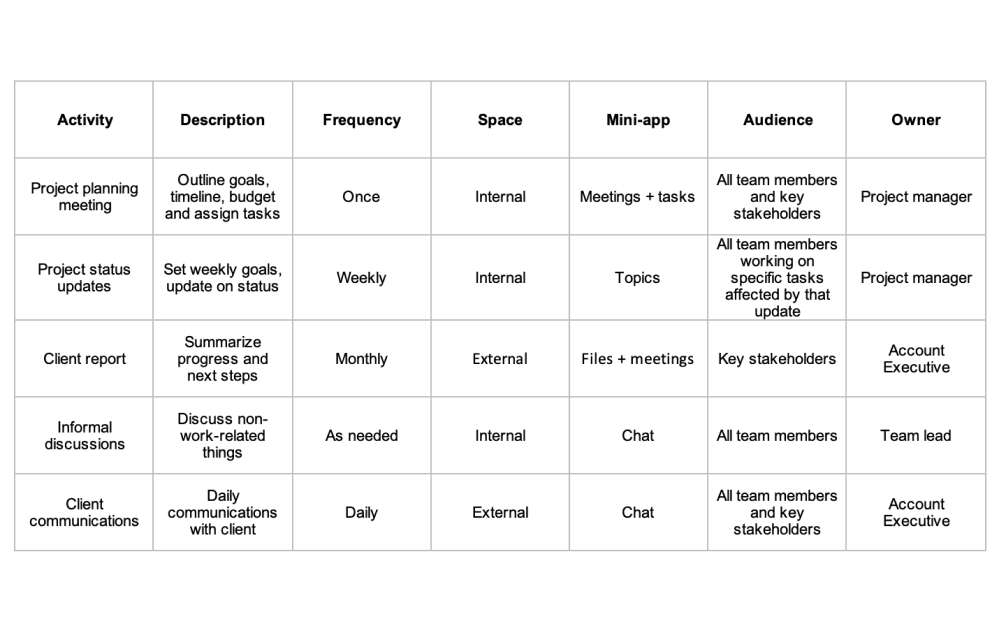What is Communication Plan? Explained
You can have the best possible team, the best product or service, and the best management tools in the market. But if you don’t have an idea of what a communication plan is (and you don’t put it into practice) you can gloriously crash down an entire business project. Or, at the very least, generate chaos and confusion among those involved.
But it works both ways. Communication planning provides a straightforward way to simplify interactions as well as minimize frustrations. And, ultimately, getting a project across the finish line.
It is a critical tool for professionals to stay fully engaged with a project and create a strong framework to build relationships with internal and external parties.
It might sound complex, but it really is all about keeping things tidy and staying organized at work. To ‘spark joy’ among your team, as Marie Kondo would say. Joking aside, a clear communication plan can really help you simplify tasks and processes.
A critical tool for asynchronous communication
As remote work is taking over workplaces around the world, a communication plan becomes even more critical to keep distributed teams in the loop.
Employees more often work from different cities, continents, and time zones these days. Walking around the workplace and getting an update from a colleague sitting next to you is no longer an option. You also can't set up a spontaneous meeting with a team member you just saw at your office.
As a result, every stakeholder needs to understand clearly where to find all the ongoing information, how the different details will be shared and whom to contact in each case (and through which channel).

Moreover, when asynchronous work takes place – with fewer meetings and more time zones across the work environment – having all the communication processes well-defined and organized becomes even more relevant.
Plus it provides an additional level of documentation that allows people to find updates easily, optimizing their time and energy to focus on the work that matters.
So, how to make communication plans effective, you might be wondering. Just keep reading. In this article, we will guide you through the process and we will give you a project charter example, so you can create your own and start rocking your comms!
But let’s start with the basics.
What is a communication plan?
Communication is a critical part of any successful project. But what is a communication plan? Well, to put it in a simple way, a communication plan is the line of action to make communication happen in a clear and organized way.
A communication plan gives you the structure to target your messages effectively across teams and clients. Also, it defines collaboration tools, communication strategies, and insights on where and how to share information.
There are two types of communication plans: if you address your teams, then your plan is internal. If you focus on your clients, then you need to develop an external communication plan.
In both cases, if, for example, there has been a weekly update on a certain project, a communication plan sets up the guidelines to update and access that information. It also defines the processes on how to contact the right person through the right channel.
Think of a communication plan as a road map to get the project team involved and keep everybody on the same page.
What to include in a communication plan?
Think about who is the communicator and the audience. Also, about what needs to be shared, as well as specific details that you can explain briefly. For instance, does it involve the team (internal) or it also involves communicating with clients (external)?
In your communication plan project management, you need to break down all the documentation, timelines, and communication channels. You also have to set expectations on how updates and critical information will be shared throughout the project.
Broadly speaking, a high-level communication plan should include:
- Goals and approach. Think about the purpose of your communication plan, how it fits your organizational strategy, and the goals that you are planning to accomplish. What are the main expectations?
- Stakeholder communications. Create a stakeholder communication plan to define who is involved in the project. Also, the audience: who is the message for? Define how often information will be shared. Will there be daily, weekly and/or monthly updates? Think about who is in charge of sending the information.
- Tools and channels. Describe the methods and channels to share briefings, communicate updates, make a presentation, and meeting agendas, among other information. Which medium or remote work tool will be used in each case?

Five key elements that a successful communication plan must have
On a more specific note, any ‘successful communication plan’ requires five specific elements, according to Forbes:
- The purpose. Think about your goals and ask yourself how you are going to reach them. How will you deliver your message to get the most impact?
- The audience. In the case of an external communication plan, define your target audience, including clients, professionals, and media. It could be useful to create an audience map to identify key audiences.
- The medium. You need to define clearly which communication channels you will use to deliver your information. We will tell you more about this very shortly and provide an example of a project charter that you might find useful.
- The timing. Timing is key. When and how often are you going to communicate your information? Set up a timing plan. Prioritize the most important tasks in your comms strategy.
- The owner. If the communications are addressed to external audiences, the media professionals, marketing, and public relations teams will be the ones in charge. If it is an internal communication plan, you must involve project managers and human resources departments. Decide who is in charge of sending the update/communication.
If you define each element properly, the communication plan will allow you to ‘put together a solid strategy that could bring more success for your business’, says product marketing expert Haseeb Tariq.
If you have read this far, you may know how to answer the question of what is a communication plan. It’s time to put theory into practice.
And now… let’s rock your comms plan!
A thing to keep in mind when you design a communication plan – either for internal or external parties – is to keep it as clear and accurate as possible.
Especially in the case of asynchronous work, it is essential to use a platform that simplifies communication and the way people interact with each other. Rock will allow you to keep your communications on point and bring all project stakeholders in one area to work effectively as a team.
On Rock, you can clearly define which spaces and mini-apps you are going to use for your communications. Ask yourself what you are going to use each feature for:
- Spaces. Do you need a specific space for your communications plan? If so, create a dedicated space and invite everyone who needs to be aware of it.
- Mini-apps. Will the communications plan go into a topic, note, or task? Think about which mini-apps are the most suitable to store and manage your plan. How about creating a specific topic for communication updates? Decide how and where you will communicate updates and changes, too.
- Integrations. Which other apps – Google Docs, Sheets, Loom, etc – will be integrated? Rock offers many integrations of external apps, so you can have it all in one place.
- Meetings. Will you need to set up meetings? If yes, integrate video conferencing apps such as Zoom or Google Meet.
- File sharing. Will you need to upload and send files? You can integrate various cloud storage providers. Everybody in a space can access your files through the Files mini-app.
Rock is very multifunctional. You can facilitate specific mini-apps such as task management, notes, chat, files or topics to share different communication updates for different teams, project management frameworks, and clients.

Example of project charter for a communications plan
Break everything down into a sample project charter and create a list. it will give you a clever vision of your communication goals and processes.
Think of activities such as weekly updates on a project. For instance, communications that your company sends every Thursday to the same client. You can create a topic on Rock to follow and store all the information up to date. You can use the project charter sample below for inspiration and adapt it to your plan.

Why do you need a communication plan?
There are many reasons that explain why a communication plan is vital for a successful project or business. The most important one is that it helps you organize the communication flows and the information you share with your team or audience.
It can also nurture cross-departmental communication between team members. And it allows you to be more strategic and effective with your conversations.
Rock can help you have all your communications in one space. You don’t have to waste time switching between apps. Also, it allows you to make sure that everyone has access to the same information. No more confusion between hundreds of spreadsheets and multiple chats.
Start a communication plan with Rock and keep everyone in tune with your comms!






















